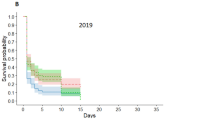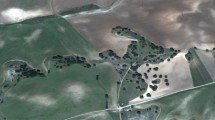Abstract
Seed predation has traditionally been considered as simply a progressive loss of seeds. However, partial consumption of tree seeds may actually assist regeneration. We quantified partial consumption of acorns by the common rabbit (Oryctolagus cuniculus) in a cork oak forest in southwest Spain (Doñana Natural Park). To examine the effects of partial consumption on germination and seedling emergence, we simulated two different levels of acorn predation (30 and 50 % cotyledon loss, representing light and heavy partial consumption, respectively). One-third of the sampled acorns presented evidence of consumption but most of the damage caused by partial consumption did not affect the acorn embryo (damage was mainly to non-vital parts of the propagule). Partial consumption caused more rapid germination and emergence than that was observed in intact acorns, but germination and emergence rate was unaffected. Heavy consumption of the acorn caused differences in root and shoot biomass as a consequence of cotyledon loss. In this greenhouse study, partial consumption was non-lethal to the acorns, and cotyledon biomass loss did not decrease the probability of successful establishment. Partially consumed seeds can therefore contribute significantly to the natural regeneration of Quercus coccifera, although it would be beneficial to conduct long-term studies focusing on seed traits and animal behaviour under field conditions.

Similar content being viewed by others
References
Andersson C, Frost I (1996) Growth of Quercus robur seedlings after experimental grazing and cotyledon removal. Acta Botanica. Neerlandica 45:85–94
Bate-Smith E (1972) Attractants and repellents in higher animals. In: Harbourne JB (ed) Phytochemical ecology. Academic Press, London, pp 45–56
Bonal R, Muñoz A (2007) Multi-trophic effects of ungulate intraguild predation on acorn weevils. Oecologia 152:533–540
Bonfil C (1998) The effects of seed size, cotyledon reserves, and herbivory on seedling survival and growth in Quercus rugosa and Q. laurina (Fagaceae). Am J Bot 85:79–87
Bossema I (1979) Jays and oaks: an eco-ethological study of a symbiosis. Behaviour 70:1–117
Branco M, Branco C, Merouani H, Almeida MH (2002) Germination success, survival and seedling vigour of Quercus suber acorns in relation to insect damage. For Ecol Manag 166:159–164
Brenchley JL, Probert RJ (1998) Seed germination responses to some environmental factors in the seagrass Zostera capricorni from eastern Australia. Aquat Bot 62:177–188
Crawley MJ, Long CR (1995) Alternate bearing, predator satiation and seedling recruitment in Quercus robur L. J Ecol 83:683–696
Díaz M, Campos PP, Pulido F (1997) The Spanish dehesas: a diversity in land-use and wildlife. In: Pain DJ, Pienkowski MW (eds) Farming and birds in Europe. Academic Press, London, pp 178–209
Díaz M, Pulido FJ, Marañón T (2003) Diversidad biológica y sostenibilidad ecológica y económica de los sistemas adehesados. Ecosistemas 2003/3. http://www.um.es/gtiweb/adrico/medioambiente/sistemasadehesados.htm
Emanuelsson U (2009) The rural landscapes of Europe: how man has shaped European nature. Swedish Research Council Formas, Värnamo
Fukumoto H, Kajimura H (2000) Effects of insect predation on hypocotyl survival and germination success of mature Quercus variabilis acorns. J Forest Res 5:31–34
Gómez JM (2003) Spatial patterns in long-distance dispersal of Quercus ilex acorns by jays in a heterogeneous landscape. Ecography 26:573–584
Gómez JM (2004) Bigger is not always better: conflicting selective pressures on seed size in Quercus ilex. Evolution 58:71–80
Gómez-Aparicio L, Pérez-Ramos IM, Mendoza I, Matías L, Quero J, Castro J (2008) Oak seedling survival and growth along resource gradients in mediterranean forests: implications for regeneration in current and future environmental scenarios. Oikos 117:1683–1699
Grove A, Rackham 0 (2001) The nature of mediterranean Europe. An ecological history. Yale University Press, New Haven
Herrera J (1995) Acorn predation and seedling production in a low-density population of cork oak (Quercus suber L.). For Ecol Manag 76:197–201
Hou X, Yi X, Yang Y, Liu W (2010) Acorn germination and seedling survival of Q. variabilis: effects of cotyledon excision. Ann Forest Sci 67:711
Hulme PE (1996) Natural regeneration of yew (Taxus baccata L.): microsite, seed or herbivore limitation? J Ecol 84:853–861
Jordano P, Herrera C (1995) Shuffling the offspring: uncoupling and spatial discordance of multiple stages in vertebrate seed dispersal. Ecoscience 2:230–237
Kikuzawa K, Koyama H (1999) Scaling of soil water absorption by seeds: an experiment using seed analogues. Seed Sci Res 9:171–178
Klein J (1920) The mesta: a study in spanish economic history, 1273–1836. Harvard University Press, Cambridge
Larsen DR, Johnson PS (1998) Linking the ecology of natural oak regeneration to silviculture. For Ecol Manag 106:1–7
Leiva MJ, Fernández-Alés R (2003) Post-dispersive losses of acorns from mediterranean savannah-like forests and shrublands. For Ecol Manag 176:265–271
Long DJ, Jones RE (1996) White shark predation and scavenging on cetaceans in the eastern north Pacific Ocean. In: Klimley AP, Ainley DG (eds) Great white sharks: the biology of Carcharodon carcharias. Academic Press, New York, pp 293–307
Lozano MZ, Lucena EP, Rodríguez MS, Gallego J (1985) Consumo de bellota por conejos en pastoreo continuo. Arch Zootec 34:257–264
Martín Vicente Á, Alés RF (2006) Long term persistence of dehesas. evidences from history. Agrofor Syst 67:19–28
Montero G, San Miguel A, Cañellas I (1998) Sistemas de selvicultura mediterránea La dehesa. In: Jiménez F, Lamo de Espinosa YJ (eds) Agricultura sostenible. Mundi-Prensa, Madrid, pp 519–554
Muñoz A, Bonal R (2008) Seed choice by rodents: learning or inheritance? Behav Ecol Sociobiol 62:913–922
Muñoz A, Bonal R, Díaz M (2009) Ungulates, rodents, shrubs: interactions in a diverse mediterranean ecosystem. Basic Appl Ecol 10:151–160
Orians CM, Thorn A, Gómez S (2011) Herbivore-induced resource sequestration in plants: why bother? Oecologia 1:1–9
Perea R, San Miguel A, Gil L (2011) Leftovers in seed dispersal: ecological implications of partial seed consumption for oak regeneration. J Ecol 99:194–201
Pérez HE, Shiels AB, Zaleski HM, Drake DR (2008) Germination after simulated rat damage in seeds of two endemic Hawaiian palm species. J Trop Ecol 24:555–558
Pérez-Ramos IM, Marañón T, Lobo JM, Verdú JR (2007) Acorn removal and dispersal by the dung beetle Thorectes lusitanicus: ecological implications. Ecol Entomol 32:349–356
Pignatti S (1978) Evolutionary trends in mediterranean flora and vegetation. Plant Ecol 37:175–185
Pons J, Pausas JG (2007) Not only size matters: acorn selection by the European jay (Garrulus glandarius). Acta Oecologica 31:353–360
Pons A, Quézel P (1985) The history of the flora and vegetation and past and present human disturbance in the mediterranean region. In: Gomez-Campo C (ed) Plant conservation in the Mediterranean area, Geobotany 7. Dr. W. Junk, Dordrecht, pp 25–43
Pulido FJ, Díaz M (2001) Regeneración del arbolado e integridad de los sistemas adehesados. In: Pulido F, Campos PS, yMontero G (eds) Beneficios comerciales y ambientales de la repoblación y la regeneración del arbolado del monte mediterráneo, pp 33–44
Pulido FJ, Díaz M (2005) Regeneration of a mediterranean oak: a whole-cycle approach. Ecoscience 12:92–102
Rey PJ, Alcantara JM (2000) Recruitment dynamics of a fleshy-fruited plant (Olea europaea): connecting patterns of seed dispersal to seedling establishment. J Ecol 88:622–633
Robbins C, Hanley T, Hagerman A, Hjeljord O, Baker D, Schwartz C et al (1987a) Role of tannins in defending plants against ruminants: reduction in protein availability. Ecology 68:98–107
Robbins C, Mole S, Hagerman A, Hanley T (1987b) Role of tannins in defending plants against ruminants: reduction in dry matter digestion? Ecology 68:1606–1615
Rodríguez-Molina MC, Torres-Vila LM, Blanco-Santos A, Núñez EJP, Torres-Álvarez E (2002) Viability of holm and cork oak seedlings from acorns sown in soils naturally infected with Phytophthora cinnamomi. Forest Pathol 32:365–372
Santos T, Tellería JL (1997) Vertebrate predation on holm oak, quercus ilex, acorns in a fragmented habitat: effects on seedling recruitment. For Ecol Manag 98:181–187
Siscart D, Diego V, Lloret F (1999) Acorn ecology. In: Rodá F et al (eds) The ecology of Mediterranean evergreen oak forests. Springer-Verlag, Heidelberg, pp 75–87
Smit C, Díaz M, Jansen P (2009) Establishment limitation of holm oak (Quercus ilex subsp. ballota (Desf.) Samp.) in a Mediterranean savanna—forest ecosystem. Ann Forest Sci 66:1–7
Sonesson LK (1994) Growth and survival after cotyledon removal in Quercus robur seedlings, grown in different natural soil types. Oikos 69:65–70
Soria FJ, Cano E, Ocete ME (1996) Efectos del ataque de fitófagos perforadores en el fruto de la encina (Quercus rotundifolia Lam.). Bol San Veg Plagas 22:427–432
Steele MA, Knowles T, Bridle K, Simms EL (1993) Tannins and partial consumption of acorns: implications for dispersal of oaks by seed predators. Am Midl Nat 130:229–238
Steele MA, Hadj-Chikh LZ, Hazeltine J (1996) Caching and feeding decisions by Sciurus carolinensis: responses to weevil-infested acorns. J Mammal 77:305–314
Steele MA, Gavel K, Bachman W (1998) Dispersal of half-eaten acorns by gray squirrels: effects of physical and chemical seed characteristics. In: Steele MA, Merritt JF, Zegers DA (eds) Ecology and evolutionary biology of tree squirrels. Virginia Museum of Natural History, Martinsville, pp 223–232
Tripathi RS, Khan ML (1990) Effects of seed weight and microsite characteristics on germination and seedling fitness in two species of Quercus in a subtropical wet hill forest. Oikos 57:289–296
Vallejo-Marín M, Domínguez CA, Dirzo R (2006) Simulated seed predation reveals a variety of germination responses of neotropical rain forest species. Am J Bot 93:369–376
Vander Wall SB (2001) The evolutionary ecology of nut dispersal. Bot Rev 67:74–117
Xiao Z, Harris MK, Zhang Z (2007) Acorn defenses to herbivory from insects: implications for the joint evolution of resistance, tolerance and escape. For Ecol Manag 238:302–308
Yang Y, Yi X (2012) Partial acorn consumption by small rodents: implication for regeneration of white oak, Quercus mongolica. Plant Ecol 213:197–209
Acknowledgments
Our special thanks go to the management of the Doñana National Park and Dehesa de Gatos S.L. for their valuable help, support and facilities. The authors also thank Clara Parejo Farnés, Verónica Sánches Lineros and Jose Carlos Muñóz Reinoso for useful field assistance. The authors thank the referees for their helpful suggestions concerning the presentation and content of this paper. Rocio Fernández-Alés provided important comments on an earlier version of this manuscript. Keith MacMillan revised the English version of the manuscript.
Author information
Authors and Affiliations
Corresponding author
Rights and permissions
About this article
Cite this article
Mancilla-Leytón, J.M., Cambrollé, J. & Vicente, Á.M. The impact of the common rabbit on cork oak regeneration in SW Spain. Plant Ecol 213, 1503–1510 (2012). https://doi.org/10.1007/s11258-012-0107-4
Received:
Accepted:
Published:
Issue Date:
DOI: https://doi.org/10.1007/s11258-012-0107-4




